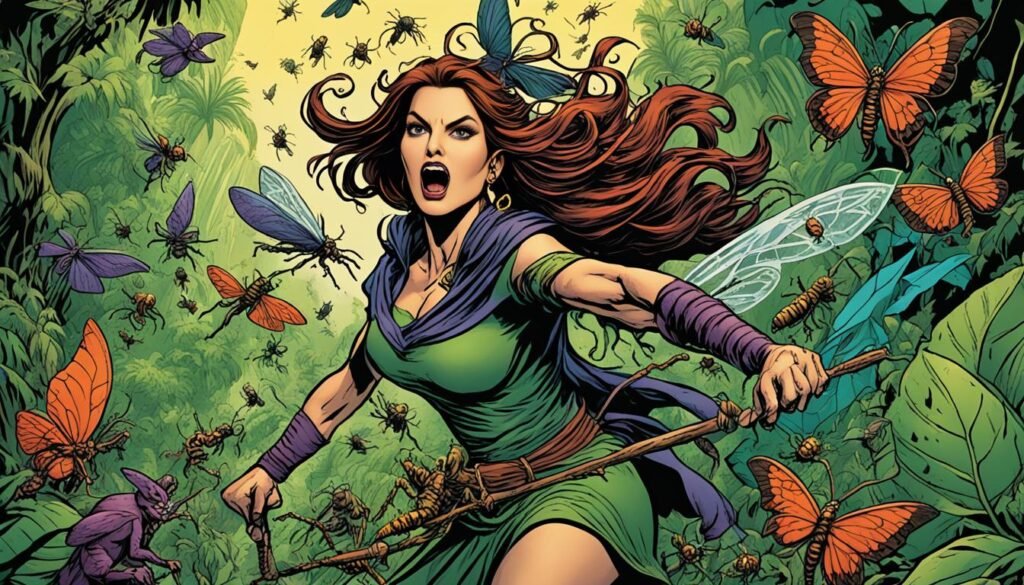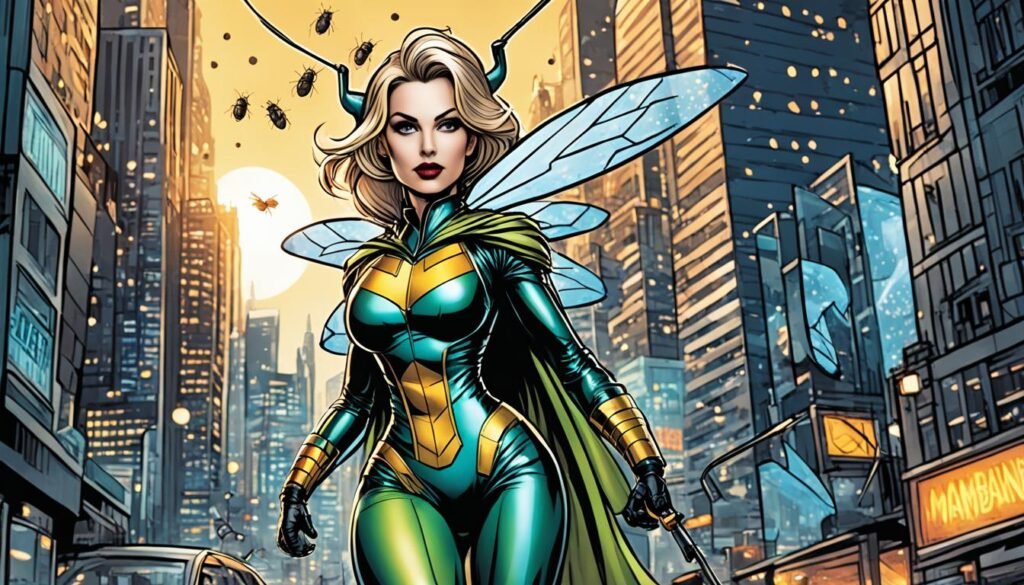In the quiet village of Tagaytay, nestled among the lush hills of the Philippines, a whispered tale lingered in the air. It was the story of an ordinary woman named Aling Marta, who, unbeknownst to her neighbors, possessed a dark and terrifying power. This power let her command legions of insects. She used these insects to do her dark work.
Aling Marta was a Mambabarang, a witch. She could use insects to harm people she wished. While the outside world carried on, Aling Marta secretly cast her spells. She used hair from her targets to control the insects, leading to their scary fate.
The Mambabarang, part of Philippine mythology, is a captivating yet sinister figure. These insect-wielding witches, looking like regular people, have the power to do black magic. For a long time, they have both scared and mesmerized the Filipino people.
In the rich tapestry of Philippine folklore, the Mambabarang is unique. They are different from Mangkukulams, who use spells and curses. The Mambabarang’s weapon is the insect, allowing them to bring torment and even death to their victims. This aspect of their power is what makes them so memorable and terrifying in Filipino myth.
Key Takeaways
- Mambabarangs are insect-wielding witches in Philippine mythology who use black magic to control insects and harm their victims.
- They are distinct from Mangkukulams, who use different methods to inflict harm, such as curses and spells.
- Mambabarangs are believed to be ordinary people with the ability to perform dark magic, using hair from their victims to bind the insects they command.
- The Mambabarang’s unique use of insects as their primary weapon has made them a enduring and chilling presence in Philippine folklore.
- The Mambabarang myth continues to captivate and terrify the Filipino people, with their sinister powers and eerie presence woven into the rich tapestry of Philippine mythology.
Introduction to Mambabarang
“Mambabarang” is a key figure in Philippine mythology. It comes from the Tagalog words for “one who” and “to cast a spell”. A Mambabarang uses insects to hurt people, making them a scary witch or sorcerer in Filipino folklore.
Origins and Meaning of the Term
The Mambabarang is not like other mythical beings. It looks just like normal people but can do black magic. This makes them very unique in Philippine mythologies.
Mambabarang in Philippine Folklore
In Filipino folklore, the Mambabarang is shown as a dark and evil being. They use insects to harm and even kill their enemies. This image of Mambabarang in Filipino folklore has fascinated people for ages.
The Sinister Powers of Mambabarang
Mambabarangs control insects like flies, ants, and worms to harm people. They use these creatures to cause pain, sickness, or even death. By tying a victim’s hair to the insect, they make sure it does their evil bidding.
Insect Familiars and Their Role
Inside their victim, the insect familiar causes terrible suffering. It can lead to intense pain, bleeding, and failure of vital organs. The victim often dies, highlighting the Mambabarang’s gruesome power.
Methods of Inflicting Harm and Torture
The way Mambabarang inflicts harm is terrifying. They might use flies and mosquitoes to swarm their victim. Or they could send ants or worms to crawl inside someone’s body.
This leads to unbearable suffering. For those attacked by Mambabarang, it’s a living nightmare. This makes the Mambabarang one of the most feared creatures in Philippine myths.

Mambabarang and Other Mythical Philippine Witches
Mambabarangs stand out because they use insects to harm people. However, in Philippine stories, they are not alone. There are also Mangkukulams, who are seen as evil sorcerers.
Unlike Mambabarangs, Mangkukulams don’t work with insects. They use spells, curses, and supernatural powers to make others sick, bring bad luck, or even cause death. Mangkukulams are often seen as more dangerous. This is because they have a wider set of magical skills.
Mambabarang in Philippine Mythology
Mambabarangs are not alone in Philippine mythology. The country boasts a wide variety of mythological creatures and beings. Each has its own unique traits and role. A standout is the Aswang. It’s an evil shape-shifter, appearing as a vampire, weredog, or ghoul. Though different, Aswangs and Mambabarangs share being viewed as evil in Philippine lore. They often bring fear and harm to people.

The Philippines has a rich mix of mythological creatures and beings. One key figure is the shape-shifting Aswang. It can turn into various forms like a vampire or vile ghoul. Aswangs and Mambabarangs are seen as evil in Philippine mythology. They are feared for their attacks on people.
The Island of Siquijor and Witchcraft
In the Central Visayas region of the Philippines lies Siquijor, an island linked to witchcraft and mysticism. It’s often called the “Island of Fire” or “Island of Witches.” Here, the art of healing and supernatural beliefs have intrigued Filipinos for years.
History and Legends of Siquijor
Siquijor can only be reached by ferry from nearby islands like Cebu, Bohol, and Dumaguete. Its remote, rugged terrain is perfect for mystery. The locals are said to have powers and abilities beyond the ordinary.
Healing Traditions and Practices
The island is a hub for various healers, each offering unique ways to cure both spiritual and physical ills. You’ll find faith healers, herbal healers, and bolo-bolo healers using prayer, traditional medications, and rituals to heal. Among them, the herbal healers stand out for their deep knowledge of the island’s forests. They search these enchanted lands for special ingredients to make their remedies.
The Siquijor Healing Festival
Annually, Siquijor welcomes crowds for its celebrated Healing Festival. It attracts people all over the Philippines. Here at Mt. Bandilaan, shamans and healers craft special potions, including the famous “gayuma.” This love potion is a huge hit. The festival highlights the island’s rich history of magic and healing.
Mambabarang: Insect-Wielding Witches
In Philippine mythology, the Mambabarang is a key character known for both its mystery and dark actions. These witches are thought to use insects to cause harm. They look like regular people but can do black magic. One special skill they have is tying a person’s hair to a bug or worm. Then they hurt the bug, causing pain to the person.
The Mambabarang is both interesting and scary in Filipino tales. They have the ability to control bugs to do evil deeds. This has fascinated people in the Philippines for a long time. It makes them a standout figure in the country’s mythical stories.
Cultural Significance of Mambabarang
Mambabarangs are significant in Philippine culture. They are tied to many beliefs and superstitions. Even today, Filipinos show caution and respect towards them to avoid any harm.
Beliefs and Superstitions
Mambabarang’s cultural influence comes from generations of beliefs and superstitions. These witches, who control insects, are both feared and respected. Many Filipinos use protective rituals or avoid them completely. This shows how Mambabarangs are part of daily life for some.
Influence on Art and Literature
Mambabarang in art and literature has deeply impacted the cultural scene in the Philippines. Stories about these dark witches have birthed various tales. These include fiction and traditional myths. Artists and writers from the Philippines use this folklore to make engaging and meaningful works. These stories capture the hearts of audiences in and out of the country.

Modern Perspectives on Mambabarang
In today’s world, belief in Mambabarangs and their powers is being questioned more. Some people think Mambabarangs come from old stories and just superstitions. Others try to explain these tales using science or psychology. Yet, many are working hard to keep the traditions alive. They know these stories are a big part of the Philippines’ culture and past.
People are writing down what they know about Mambabarangs and how they’re seen. They’re also teaching others about these creatures to make sure others learn. This teaching is to ensure the next generation knows. It’s a tough job to keep the old beliefs in mind while considering what we know now about Mambabarangs. Balancing these views will be key as time goes on.
Famous Mambabarang Stories and Legends
Philippine folklore and mythology are full of Mambabarang stories and legends. These tales tell of witches that control insects and the scary events that follow. They also talk about how people fight back using ancient rituals and spells.
In one story, a young woman was attacked by a Mambabarang. This witch used a strand of hair to control mosquitoes. The bugs fed on the woman’s blood, making her very sick. A healer saved her with a special ritual that ended the curse and drove the insects away.
There’s another story about a farmer and a Mambabarang. The witch was angry because the farmer didn’t share his crops. So, she sent ants to ruin his food and stuff. The farmer got help from a shaman. With the shaman’s help, he defeated the witch and broke the curse.
These famous Mambabarang stories show how powerful and interesting these witches are. They prove that people can overcome evil with their cleverness and strength.
Encounter with a Mambabarang: Personal Accounts
Mambabarangs are often talked about in myths and legends. But, many people say they’ve really seen these insect-wielding witches. Their stories show how deep the Mambabarang’s impact is in the Philippines.
Mang Eking, who is 73, tells of his adventure on Siquijor Island. He was there for 30 hours in September. During his visit, he met two mananambal and a mangkukulam. They showed him old ways of healing that use both spirit and hands-on work.
Another man, Kuya Centé, saw a figure that seemed like a Mambabarang. This figure was using a special bottle with nature items and oil inside. Kuya Centé shared that getting protection against evil spirits costs P2,000. This shows how much people still believe Mambabarangs have strong powers.
First-hand experiences with Mambabarang tell us about the deep fears and beliefs around them in the Philippines. These stories remind us that Mambabarangs’ stories are still very powerful today. Even in our modern times, their influence remains strong.

Mambabarang in Popular Culture
The Mambabarang is no longer just a myth. It’s now a part of Philippine popular culture. You find them in Philippine cinema and television shows. They play leading roles as scary characters or key story elements.
Representation in Films and TV Shows
Mambabarangs star in many Filipino films and television shows. These movies and series show their power in a frightening way. They focus on their evil abilities and the ways they perform their dark rituals. This has made them a staple in the Philippine cultural landscape.
Mambabarang in Literature and Comics
Besides being in the Philippine film and television industry, Mambabarangs also show up in local literature and comics. They feature in everything from old folktales to today’s novels and comic books. This has inspired writers and artists, keeping the Mambabarang’s mystery alive.
Protection and Countermeasures Against Mambabarang
The threat of Mambabarangs has led to the creation of many protective practices in Filipino culture. People use specific rituals, wear protective items, and ask for divine help. These traditional beliefs and practices combine local and Catholic traditions to stay safe from the Mambabarang’s attacks.
Traditional Beliefs and Practices
To safeguard against Mambabarangs, certain rituals and talismans are key. This protection can come from amulets crafted with natural elements like sacred plants, stones, or animal parts. Prayers, incense burning, and cleansing ceremonies help fortify this spiritual defense too.
Local experts, including healers and spiritual guides, know how to heal Mambabarang curses. They use plants, specific words, and rituals to free victims from the insects. This process aims to keep people safe and well.
| Traditional Countermeasures Against Mambabarang | Description |
|---|---|
| Amulets and Talismans | Blessed objects made from natural materials, believed to provide spiritual protection |
| Rituals and Prayers | Ceremonial practices, including the burning of incense and the recitation of specific prayers |
| Spiritual Healing | Practices by traditional healers and practitioners to expel insects and restore well-being |
These traditional beliefs and practices are deeply valued by the Filipino people. They represent a rich heritage and help against the threat of Mambabarangs.

The Future of Mambabarang Mythology
The future of the Mambabarang mythology and its place in Philippine culture is a hot topic. People are debating where it stands as the world changes. Some want to keep the stories and practices alive to share with younger folks. This helps to save the Mambabarang cultural heritage and the deep beliefs that make up Philippine identity.
In today’s world, beliefs face tough questions from science and new ways of thinking. Finding a way to keep the Mambabarang stories alive while fitting into modern life is hard. This challenge is for everyone, not just scholars and advocates.
The Masbateño or Minasbate language, spoken by many in the Philippines, is key to the Mambabarang’s future. It’s closely related to the Visayan languages. This shows how the Mambabarang stories are changing over time, mixing with other languages and cultures.
To keep the Mambabarang stories alive, many groups need to work together. Scholars, advocates, and everyday people all play a part. This teamwork can help the Mambabarang cultural heritage thrive in the modern world. It ensures that these stories keep fascinating and inspiring people for years.

Conclusion
Mambabarangs are the insect-wielding witches of Philippine myths. They are a captivating part of the country’s culture. These mythical beings, with their dark powers, have fascinated Filipinos for generations. They use insects for evil deeds.
Studying Mambabarangs offers a look into deep-seated beliefs and traditions. These elements have shaped the country’s myths. The story of the Mambabarang myth weaves into the nation’s cultural fabric.
As the modern age progresses, keeping the Mambabarang’s cultural relevance is key. It merges tradition with the present, ensuring cultural uniqueness is kept alive. This effort shows the strength and flexibility of the nation’s culture.
Despite facing doubt and logical challenges, the Mambabarang myth endures in the Filipino mind. Discovering more about these witches can enrich our grasp of Philippine mythology. This leads to a better understanding of the country’s culture and its lasting myths.

